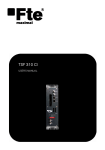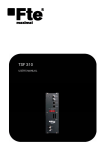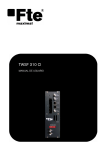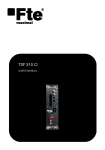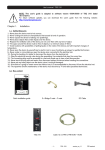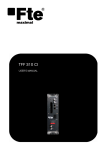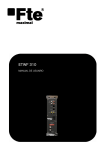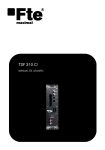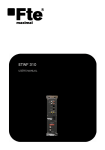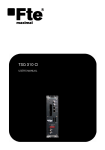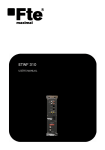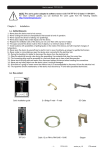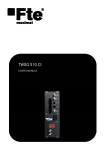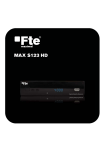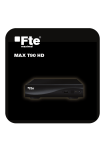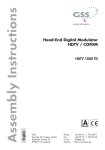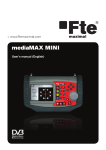Download User`s manual
Transcript
TWSF 310 CI USER’S MANUAL User’s manual · TWSF 310 CI NOTE: This user’s guide is adapted to software version v.0.1.50 of TWSF 310 CI dated 28/05/2014. For future software updates, you can download the user’s guide from the following website: http://www.ftemaximal.com/ Chapter 1. Installation. 1.1. Safety Measures 1.- Never place the device next to hot sources. 2.- Never undergo the device to temperatures that exceed its level of operation. 3.- Never expose the device to leaking nor spattering. 4.- Never place objects that contain liquids over the device. 5.- Respect the ventilation slots of the device, do not cover them with any kind of object. 6.- The space around the device must be free of objects, in a minimum radius of 40cm. 7.- Avoid locations with possibilities of spilling liquids on the inside of the device, and with important changes of temperature. 8.- Never open the device by yourself due to electric risk. In case of problems, go always to qualified technicians 9.- Never, under no circumstances, open the device when connected to the electrical net. 10.- During the handling it is better to disconnect the device from the electrical net. 11.- Obey the electricity security rules during the assembling. Use materials that obey the current law. 12.- The connecting plug must be accessible in a fast and simple way to have a fast disconnection. 13.- Never touch the plug with wet hands. Also, disconnect always the device before handling the connections. 14.- Never put any heavy object over the device, since it could get damaged. 15.- If the device is going to remain some time without use, it is recommendable to disconnect it from the electrical net. 16.- The repairmen and the maintenance of the device must be done by TV and radio specialised technicians. 1.2. Box content Quick installation guide 2 x Link F male – F male DC Cable TWSF 310 CI Cable 12 cm PIN to PIN RJ45 – RJ45 Stopper -1- TWSF 310 CI version_en_2.0 FTE maximal User’s manual · TWSF 310 CI The TWSF 310 CI will be provided with a double DVB-T output that will allow distributing the channels of the tuned transponders in two consecutive multiplex. In order to configure the device we will have two selectable modules. The options of configuration are independent. With the following exceptions: - The output channel of the second module will be set automatically as the consecutive channel after the one configured in the first module. - The output level of the multiplex will be set by the output level configured in the first module. 1.3. Description and connections The module TWSF 310 CI is used for the reception of free channels that obey the DVB-S/DVB-S2 standards. Each module allows the reception of two complete transponders in DVB-S (QPSK) / DVB-S2 (QPSK/8PSK), and the subsequent modulation in DVB-T (COFDM) of them. A feature of this equipment is its modulator in Vestigial Side Band (or VSB). This modulation can be used to distribute adjacent channels in one distribution without any interference problem. Each module has one Loop connector to cascade several modules at input and a Mix connector to do same in output channels. The output channel is selectable between C2 and C69. All parameters are programmed by the means of PRO 201 or the EVO or MINI series of field strength meter, and they are monitored in the display of programmer or in the TFT screen of field strength meter. TWSF 310 CI has two Common Interface slots. TWSF 310 CI 1 5 6 7 2 8 9 10 1. Two-colored led*: It indicates the different states of the device. 2. CI: Common Interface. 3. OUT: This connector supplies the modulated channel according to the selected standard in the module and mixes it with all the signals that it receives through the MIX connector 4. MIX: Input of mixing of the module. 5. LNC IN: To connect to the LNC or to the LOOP OUT output of the previous module 6. LOOP OUT: To connect to the ANT IN input of the next module. 7. RS 232: Ethernet connector to cascade modules with the RCM 310 telecontrol unit with the RJ45/RJ45 cable provided. 8. PRO 201: Ethernet connector to make the programming with the programmer. 9. LNC IN 2: Second input to connect to the LNC. 10. DC connectors: It has two connectors for connecting between modules. 3 4 *States of two-colored leds 1. Initialization mode - Green: main application charged. - Blinking Green: Completing the initial sequence, at the moment when the module gets initialized, the led will turn into one of the states the operating mode. - Red: Phase of initializing the module. 2. Operative Mode - Green: The system is working properly. - Orange: At least one critical event has been recorded in the module. The led will only change into green when the registration of events has been read by the programmer. - Red: Error or alert detected in the running of the device, the led will be on only as long as the error/alert is present. Once the error or the alert disappears, the led will change into orange because the error/alert is stored in the registration of events. 3. Programming mode - When the module detects an external programmer, the led will blink in the next sequence: green-orange-red. - Once you leave the programming mode, the led will turn into the corresponding operating mode. -2- TWSF 310 CI version_en_2.0 FTE maximal User’s manual · TWSF 310 CI Stages of transmodulator TWSF 310 CI Input 1 Input 2 Selection of a tuned satellite transponder Transmodulation TP 1 TP 2 The tuned channels of the transponders are modulated according to the DVB-T rules in two multiplex. In cases where the transponder has encoded channels, if you wish to distribute them freely, you will have to link a PCMCIA + subscriber card to each one of the two outputs of the multiplex. Out Configuration of the channel and the output parameters of the multiplex. The channel of the second multiple will be set by default as the consecutive channel of the one in the first multiplex. 1.4. Programming TWSF 310 CI has two ethernet connectors. In order to make the programming of the module you have to connect the corresponding programmer to PRO 201 connector. You can make the programming through the PRO 201, PRO 300 programmers and also through the mediaMAX EVO and mediaMAX MINI field strength meter. 1.4.1. Programming modes With mediaMAX EVO / mediaMAX MINI field strength meter you can carry out the programming of all the modules consecutively as long as they are interconnected with each other through the RJ-45 cable supplied with each unit. Through PRO 201or PRO 300, the programming is made module by module. -3- TWSF 310 CI version_en_2.0 FTE maximal User’s manual · TWSF 310 CI 1.4.2. Programming Below you will find the steps to follow in order to make the programming both from corresponding EVO and MINI field strength meter as well as from PRO 201 and PRO 300. mediaMAX EVO / mediaMAX MINI In order to start programming the TWSF 310 CI transmodulator, you will have to go to “Tools” option through the key 8 of your field strength meter and to select the “Transmodulator Prog.“ option. Then, it will proceed to recognize the module and to show the main menu. In the “Transmodulator Prog.” are shown the different configuration options that this tool offers: 1. Select Device The field strength meter allows carrying out the programming of one or several transmodulators from an only transmodulator. Without interconnection of modules. An only module connected. It will allow you to choose between two units with an only device connected to the programmer (Unit 1 or Unit 2). Interconnection of several modules, you can select which module you wish to program. -4- TWSF 310 CI version_en_2.0 FTE maximal User’s manual · TWSF 310 CI 2. Device Status In the option “Device Status” are specified the main parameters of the module at this moment. - Front End: It indicates whether the module is hooked or without signal. - Input bit rate: Transfers of data in the satellite tuner input. - Output bit rate: Transfer of data in the module output. - BER before and after Viterbi: It indicates the error rate of bits of the input signal before and after the correction produced by Viterbi algorithm. - MER: Parameter that indicates the quality of the input modulated digital signal, expressed in dB. - Noise Margin: It indicates the difference between the value of current C/N and the value of C/N at the point of pixilation of the signal, that is, the quantity of dB of C/N measure that are needed to lose the input signal. -Temperature: It indicates the current temperature of the module in ºC. - Fan PWM: It points out the current efficiency of the fan of the device, indicated in %. 3. Set Front End In this option you will be able to configure the input parameters of the satellite signal: - Local oscillator: Selection of the local oscillator that you wish to use: FI, KU, C, K9750, K10000, K10600, K10700, K10750, K11250, K11300 and K11325. - Frequency (MHz): Transponder frequency that you wish to tune. - Symbol speed: Symbol speed required by the transponder. - Auto symbol rate: You will be able to select if the detection of the Symbol Rate is going to be Automatic (On) or Manual (Off). - In Manual mode (Off), the value of the Symbol Rate should be fixed by the user based on the provider’s information. - In Automatic mode (On), the meter will automatically identify the SR when a Satellite carrier is tuned. This feature is very useful when the provider’s information is unknown. The SR value found will appear in the field of selection of the SR menu. This value found by the meter could not correspond exactly to the real broadcast SR, but to a very close value. Note: The Automatic Symbol Rate feature does not work when the carrier quality is very poor or/and with a very low Power Level. - DVB: This option allows selecting the standard DVB of the transponder that you want to tune. Options: DVB-S1, DVB-S2 and auto. - LNB Supply: In this option you can set the parameters concerning the LNB: - RF IN Voltage: 13V, 18V and Off. - 22 kHz Tone: Off, On and Auto. - DiseqC Switch: A, B, C, D and Off. 4. Modulator Set Up This option allows configuring the DVB-T/DVB-H modulator of the device. - Bandwidth: Selection of the Bandwidth of the modulated signal: 8MHz, 7MHz, 6MHz and 5MHz. The 5MHz option is only supported by DVB-H standard. - FFT Mode: 8K, 4K and 2k. The 4k option is only supported by DVB-H standard. -Spectrum inversion: Activate or deactivate the spectrum reverse in the modulation. - Guard interval: Allows selecting the guard interval of the modulation: 1/4, 1/8, 1/16 and 1/32. - FEC: Indicates the relationship between the redundant bits and the transmitted information bits: 1/2, 2/3, 3/4, 5/6 y 7/8. For example, in a FEC = 2/3 relation we will find 2 information bits and 1 redundant bit. -5- TWSF 310 CI version_en_2.0 FTE maximal User’s manual · TWSF 310 CI - Modulation: Output modulation format: 4 (QPSK), 16 (16 QAM), 64 (64 QAM). - Advanced settings: - Mode: Selection of the modulation standard: DVB-T and DVB-H. Note: The output useful bits rate will depend on the following parameters: Bandwidth, guard interval, FEC codification and modulation. In the Attachment I you will find all the information related to the resulting useful bit rate in each configuration. 5. Set Output channel In this option you can configure the different parameters of the cable signal. - Channel standard: It allows you to select the channelling of the cable signal standards. Options: BG, BG, PAL BG IT, LL, M NTSC, PAL M, PAL N, PAL DK, PAL I, BB_AU, DK PAL, L PAL. - Channel: Output channel of the cable modulation. When you select the output channel, the field “Frequency (MHz)” will be modified automatically, adapting itself to the selected channel. Options: C2-C69. - Frequency (MHz): Output frequency of cable modulation. When you modify this field, the field “Channel” will be also modified, indicating the channel equivalent to the selected frequency in the case that this frequency corresponds to the frequency of a channel. Options: 47-862 MHz. - Level: Regulation of the output level of the modulated signal. Options: 0-15dB. - Calibration: Allows the realization of two tests in order to verify the correct running of the device. - Deactivate output: It allows activating or deactivating the output of transmodulator. - Switch output to CW: It allows activating or deactivating the DVB-T / DVB-H modulation, allowing visualizing the carrier without modulation in the selected frequency. 6. System This option provides information of the transmodulator. - System logfile: In this field are indicated the registered events in the module. - Read log: It allows reading the registered events in the module. - Clear log: It allows deleting all events stored until this moment. - Export log to USB: It allows you to export all events registered to the connected USB device. - NM low Limit (dB): An event of error will be recorded when the value of Noise Margin is lower than the set value. - NM high limit (dB): Once the event of error is recorded (Noise Margin < Limit Lower NM), this will be Noise Margin value that will have to be exceed so the module stops being in error. - Clear log all devices. It allows deleting the events report of all the interconnected modules. - Factory default: This option restores the values by default of the transmodulator. - System information: It allows you to visualize the basic information of the module: model, serial number, firmware version, etc. -6- TWSF 310 CI version_en_2.0 FTE maximal User’s manual · TWSF 310 CI - Settings: This option allows saving and loading the configuration of the module, carrying out firmware update or making an adjustment of the time and date of the module. - Clock: - Set Date and time: Setting of the date and time of transmodulator. It is appropriate to maintain these parameters set in order to have the registration of errors linked to the current time and date. - Set date/time all devices: Loading the current date and time of the module in the rest of interconnected modules. - Alias: - Write alias: It allows you to assign a name/alias to the module you are programming. Option only available when the Alias Auto option is configures as “none” (manual mode). - Auto Alias: It allows configuring the name/alias of the modules automatically. Options: Channel, Frequency, Service, None. - Upgrade: - Send Firmware from USB: It allows carrying out the firmware update from the USB device. - Send firmware to all: It allows carrying out the update of all the modules that are interconnected at the same time. - Configure all devices: - Input values to all devices: It allows copying the current input configuration in all the interconnected modules. - Modulator values to all devices: It allows copying the configuration of the current modulator in all the interconnected modules. - Output values to all devices: It allows copying the current output configuration in all the interconnected modules. - Factory default to all devices: It allows making values by default to all the interconnected modules. - Activate next output: - It allows activating or deactivating the output of the second Unit. -7- TWSF 310 CI version_en_2.0 FTE maximal User’s manual · TWSF 310 CI 7. Program management - New program: This option allows creating a program with the current configuration of a module or group of modules. - Load program: It allows loading a previously created program on a module or group of modules. - Delete program: It allows deleting a program. - Device to process: - Current: The creation or loading of a program will be applied only in the module that is currently connected. - All: The creation or loading of a program will be applied to the whole group of connected modules. - Working disk: With this option we have the possibility of choosing if we want to work into the internal disk or in the external storage device USB 2.0. Once the option is selected, a dialog box will appear and we will be able to choose among three different options: - Auto: The Meter decides where the data will be stored. If there is external memory connected, the Meter will store the data in it. If not, it will use the internal memory. - USB: The Meter always will try to use the external memory connected to the USB port. If this memory has not been connected an error message will be shown, reminding that there was an error storing the data and it will be not stored. - Internal: Always the internal memory is used to store the data. - Load programs from USB: This option allows importing programs from a USB memory to the field strength meter. Before using this option you must connect a USB memory. - Save programs to USB: This option allows copying the programs stored in the external USB 2.0 storage device. - Write Alias: It allows saving the alias of the module in the program. Options: Yes/No 8. Set Output Services This option allows making the selection of the services that you wish to include in the output multiplex. - Add/Remove services: It allows adding the services to the multiplex and also removing the ones previously included. The lower bar informs about the available space in the output multiplex. As you add more services, the space available will decrease. Once you have tuned a transponder in the “Input Set Up” section and you have selected the DVB-T/DVB-H modulator configuration in the “Modulator Set Up” section, you can make the assignment of the services that are going to be included in the output multiplex “Adding/Removing services”. Adding services: 1. Select “Service to add” option 2. Select one of the transponder services you want to add. -8- 3. Once you have chosen the service, select the “Add/Rem” button to include the service in the multiplex. TWSF 310 CI version_en_2.0 FTE maximal User’s manual · TWSF 310 CI Note: It is not recommended to exceed the 85% of the maximum capacity of the multiplex due to the possible variability of the bits rate of the inputs services. Excessive capacity It is recommended to remove services Recomendad capacity (lower to 85%) Removing services: 1. Select the “Service to remove” option. 2. Select one of the transponder services you want to remove. 3. Once you have chosen the service, select the “Add/Rem” button to remove the service in the multiplex. - Remove all services: It allows removing all the services included in the multiplex. - Modify LCN: The LCN function allows assigning automatically a predetermined position to each one of the services of the multiplex. This function will allow the users who have a receiver with LCN support to make the ordination of channels automatically. Note: If in the existing installation there are already services that have LCN system, you will have to configure the position of the module services in order to avoid conflicts with other net services. - Bandwidth limitation: It allows selecting the % of the capacity of the output channel. - Auto service addition: - On: It selects the services automatically when an input carrier is tuned and when the list of selected services is empty. The receiver will have this state by default. - Always: It selects the services automatically every time a new input carrier is tuned. This state is only recommended to be used for making test in the module. - Off: The automatic mode is deactivated; the services have to be manually selected. - Advanced settings: - Network: It allows making the adjustment of the identification parameters of the multiplex. - TS ID: Transport Stream identification value. It is recommended to configure a value different from TS ID for each one of the output multiplex configured. - Net ID: Net identification value -9- TWSF 310 CI version_en_2.0 FTE maximal User’s manual · TWSF 310 CI - Original Net ID: Original net identification value - Network Name: Name associated with the net. - Tables: It allows modifying the value of the following information tables of the DVB:. - NIT - SDT - PAT - Services: - Change service name: It allows changing the name of the service manually. In order to do so, please choose the service in the first line and then write the new name in the second line. Then you have to press “modify” in order to save the changes. - HDSimulCast: In cases where we receive in an installation the same channel in high definition and in standard definition, the HD Simulcast function allows to exchange the position of the LCN of both channels. If the user has a device compatible to HD Simulcast and the module has been correctly configured, when tuning the standard definition channel, it will move to its position in high definition automatically. This option allows modifying manually the position of the LCN, exchanging the standard position into the high definition position. In the first line you have to select the high definition service and in the second line you have to select the same service but in standard definition. - Change in Service ID: From this position you can change the PID Number of the chosen service. Change service name HDSimulCast Change Service ID Next it is attached the identification table (NID/ONID) of the main satellites. You will be able to find more information in the law ETSI TR 101 162 v1.2.1. Satellite Hotbird 13ºE (Eutelsat 13ºE) Astra 19.2ºE Astra 23ºE Astra 28,2ºE Nilesat 7ºW Hispasat 30ºW Net ID 318 1 3-25 2 2048 33 Original Net ID 318 1 3-25 2 2048 33 - 10 - TWSF 310 CI Description Eutelsat 13ºE System Astra Satellite Network 19,2ºE Astra n (n=1-23) Astra Satellite Network 28,2ºE Nilesat 101 Hispasat Network 1 version_en_2.0 FTE maximal User’s manual · TWSF 310 CI 9. Common Interface This option allows checking the information and configuring the parameters regarding the conditional access. - CI Menu: From here you can reach the menu of the card inserted in the CAM. - Decryption: From this option you can add or remove manually the services that are being decoded by the card. - Remove all decrypted serv.: From this option you can remove all the services that are decoding the conditional access card. - Reset CAM: It allows making a reset in the CAM. - CAM watchdog system: In cases where the encoded services stop working you can use one of the following options. - Deactivate: No actions will me made in the CAM. - Update: When it is detected that the decryption of the CAM has been lost, the rights will be sent systematically until the decryption gets back. - Reset: As soon as the loss of decryption of the CAM is detected, a reset will be made. - Both: Once the loss of decryption of the CAM is detected, the rights will be sent several times until the decryption gets back. In cases where it does not get back the module will make a reset of the CAM. - CAM Reset after: It makes a reset of the CAM alter a set period of time. Options: 0, 5 min, 10 min, 15 min - CI daily reset: By activating this option we will be able to make a daily reset of the CAM. - CI daily reset time: Time when the CAM resets in case the “CI daily reset” option is activated. - Activated slots: It allows selecting the numbers of CAM modules used. Options: 1 only or 1 and 2. PRO 201 Note: From PRO 201 programmer you can only carry out the programming of a single module, in order to carry out the programming of several modules at the same time you have to use a mediaMAX EVO or mediaMAX MINI series field strength meter. When you connect the PRO 201 programmer, it will proceed to recognize the module and to show the main menu. In the main menu are shown the different options for configuring the transmodulator. TWSF310CI >Manual< Auto Config We have to use the “Up” and “Down” buttons of the keyboard in order to move to the different options, and to get into the submenus we have to press “OK” button. 1. Manual Inside the “manual” menu there are specified the different options for setting up the input, output and modulation parameters. Note: It will allow you to choose between two units with an only device connected to the programmer (Unit 1(Mux 0) or Unit 2 (Mux 1)). TWSF310CI >Mux 1< Mux 0 1. This field shows the type of parameter that is selected at the moment. Options: Input Sat, Out Terr, Out TV. 2. This field shows the parameter that is selected. In order to move around the different options we have to use the “Up” and “Down” buttons of the keyboard.. Click on OK to edit the selected parameter and Right/Left for changing it. Once it is configured press OK. TWSF310CI *Input Sat RF level: 013 >LO Freq: LO KU Freq: 11509 Satellite input ( Input Sat) In these options you will be able to configure the input parameters of the satellite signal: - L.O. freq (Local oscillator): Selection of the local oscillator that you wish to use: FI, KU, C, K9750, K10000, K10600, K10700, K10750, K11250, K11300 and K11325. - 11 - TWSF 310 CI TWSF310CI *Input Sat Symbol Rate: 27500 >Antenna: 13V+22k Diseqc: NONE version_en_2.0 FTE maximal 1 2 User’s manual · TWSF 310 CI - Freq (Input Frequency (MHz)): Transponder frequency that you wish to tune. In order to introduce the frequency, press the “OK” button and the cursor will be placed over the frequency. With the keys of the cursor, we can move through all the digits and change the values. Press “OK” in order to save the value. - Symbol Rate: Symbol speed required by the transponder. In order to introduce the symbol rate, press the “OK” button and the cursor will be placed over the frequency. With the keys of the cursor, we can move through all the digits and change the values. Press “OK” in order to save the value. - Antenna: Feeding/tone towards the LNC. Options: 0V, 13V, 13V+22kHz, 18V, 18V+22KHz, 13V+AUT, 18V+AUT. - DiseqC: In this option you can set the DiseqC configuration: A, B, C, D and None. - Auto SR (Auto Symbol Rate): You will be able to select if the detection of the Symbol Rate is going to be Automatic (On) or Manual (Off). - In Manual mode (Off), the value of the Symbol Rate should be fixed by the user based on the provider’s information. - In Automatic mode (On), the meter will automatically identify the SR when a Satellite carrier is tuned. This feature is very useful when the provider’s information is unknown. The SR value found will appear in the field of selection of the SR menu. This value found by the meter could not correspond exactly to the real broadcast SR, but to a very close value. Note: The Automatic Symbol Rate feature does not work when the carrier quality is very poor or/and with a very low Power Level. - Mode: This option allows selecting the standard DVB of the transponder that you want to tune. Options: DVB-S1, DVB-S2 and auto. Terrestrial modulation (Out Terr) These options allow configuring the DVB-T/DVB-H modulator of the device. TWSF310CI *Out Terr Modulation: 4 >Invert: No GI: 1/32 - Modulation: Output modulation format: 4 (4QAM), 16 (16QAM), 64 (64QAM). - Invert (Spectrum inversion): Activate or deactivate the spectrum reverse in the modulation. - GI (Guard interval): Allows selecting the guard interval of the modulation: 1/4, 1/8, 1/16 and 1/32. - BW (Bandwidth): Selection of the Bandwidth of the modulated signal: 8MHz, 7MHz, 6MHz and 5MHz. The 5MHz option is only supported by DVB-H standard. - Tx Mode (FFT Mode): 8K, 4K and 2k. The 4k option is only supported by DVB-H standard. - FEC: Indicates the relationship between the redundant bits and the transmitted information bits: 1/2, 2/3, 3/4, 5/6 and 7/8. For example, in a FEC = 2/3 relation we will find 2 information bits and 1 redundant bit. - Mode: Selection of the modulation standard: DVB-T and DVB-H. Note: The output useful bits rate will depend on the following parameters: Bandwidth, guard interval, FEC codification and modulation. In the Attachment I you will find all the information related to the resulting useful bit rate in each configuration. Output configuration ( TV output) In these options you can configure the output parameters of the terrestrial signal. - RF Channel (MHz): Output frequency of terrestrial modulation. In order to introduce the frequency, press the “OK” button and the cursor will be placed over the frequency. With the keys of the cursor, we can move through all the digits and change the values. Press “OK” in order to save the value. Options: 47-862 MHz. - RF Level: Regulation of the output level of the modulated signal. Options: 0-15dB. TWSF310CI *Out TV Mode: DVB-T >RF Channel: 474000 RF Level: 013 Summary table: Satellite input - L.O. frequency - Input Frequency - Symbol Rate - Antenna - Diseqc - Symbol rate auto - DVB Mode Terrestrial output - Modulation - Invert (Spectrum Inversion) - Guard Interval (GI) - Bandwidth (BW) - Tx Mode (FFT Mode) - FEC - Mode - 12 - TV output - RF Channel - RF Level TWSF 310 CI version_en_2.0 FTE maximal User’s manual · TWSF 310 CI 2. Auto This option allows saving and loading the configuration of the module in the PRO 201 programmer. TWSF 310 CI > *Read from Module* *Write to Module * - Read from module: It stores the current configuration of the module in the memory of the programmer. The steps to make a correct reading of the headend are specified below: TWSF 310 CI > *Read from Module* *Write to Module * 1. Select the option “Read from module” through Up/Down buttons. Press OK to continue TWSF 310 CI TWSF 310 CI CFG:03 Operation finish Free position 2. Select the position of “CFG” memory where you wish to save the current configuration of the module. 3. A window will appear and it will let you know that the reading made has been correct - Write to module: It loads in the module one of the configurations previously saved in the memory of the programmer. The steps to make a correct configuration of the headend are specified below: TWSF 310 CI > *Write to Module * *Read from Module* 1. Select the option “Write to module” through Up/Down buttons. Press OK to continue TWSF 310 CI TWSF 310 CI Mux: 0 CFG:01 Freq:11362 Sr:27500 Output Freq:850000 2. Select the position of the “CFG” memory that you wish to copy in the module. Please verify that the data of the selected memory correspond to the channel that you wish to copy. Through the up/down keys, it commutates between the 2 units of the module (Mux 0 / Mux 1) Operation finish 3. A window will appear and it will let you know that the configuration made has been correct 3. Config In “Config” option the information concerning the transmodulator is given. TWSF 310 CI Global update >Read LOG file Delete LOG file - Read log: It allows reading the registered events in the module. TWSF 310 CI Global update >Read LOG file Delete LOG file 1. Select the option “Read LOG file” through Up/Down buttons. Press OK to continue TWSF 310 CI TWSF 310 CI N:00001 Status:03 01/08/14 09:05:02 Front-end lock OK to Show LOG 2. Press OK again to show the log file. - 13 - 3. A new window will appear. It will show the information about the registered events in the module. Press the following keys in order to scroll up and down the screen: “up/down”. TWSF 310 CI version_en_2.0 FTE maximal User’s manual · TWSF 310 CI - Delete LOG file: It allows deleting all events stored until this moment. - Factory default: This option restores the values by default of the transmodulator. - Update FW: It allows carrying out the firmware update from the programmer. - (1) Network Name: Name associated with the net. - (1) TSID: Transport Stream identification value. It is recommended to configure a value different from TS ID for each one of the output multiplex configured. - (1) NID: Net identification value - (1) ONID: Original net identification value - (1) Output services: This option allows making the selection of the services that you wish to include in the output multiplex. Once you have tuned a transponder and you have selected the DVB-T/DVB-H modulator configuration, you can make the assignment of the services that are going to be included in the output multiplex “Adding/Removing services”. - Adding Services TWSF 310 CI BW usage 000% Delete services >Add services TWSF 310 CI Input 035 % PID:06200 arte HD +Add 1. Select the option “Add services” through Up/Down buttons. Press OK to continue. 2. Select one of the transponder services you want to add, through Left/Right keys and select the “+Add” button to include the service in the multiplex TWSF 310 CI Operation finish 3. A window will appear and it will let you know that the operation made has been correct. - Deleting Services TWSF 310 CI BW usage 083% >Delete services Add services TWSF 310 CI Input 083 % PID:06000 Das Erste -Rem --All 1. Select the option “Delete services” through Up/Down buttons. Press OK to continue. 2. Select the service you want to delete with the Left/Right keys. Then press OK over “-Rem” in order to remove it, or press OK over “--All” in order to delete all the services of the multiplex. TWSF 310 CI Operation finish 3. A window will appear and it will let you know that the operation made has been correct. Note: It is not recommended to exceed the 85% of the maximum capacity of the multiplex due to the possible variability of the bits rate of the inputs services. Note: (1) You have to select in which one of the two modules you want to make the configuration in each case. - (1) Change service name: It allows changing the name of the service manually. - (1) LCN: The LCN function allows assigning automatically a predetermined position to each one of the services of the multiplex. This function will allow the users who have a receiver with LCN support to make the ordination of channels automatically. Select a channel through Left/Right buttons and introduce the position. Press the “OK” button and the cursor will be placed over the number. With the keys of the cursor, we can move through all the digits and change the values. Press “OK” in order to save the changes. TWSF 310 CI LCN:00004 arte HD Note: If in the existing installation there are already services that have LCN system, you will have to configure the position of the module services in order to avoid conflicts with other net services. - 14 - TWSF 310 CI version_en_2.0 FTE maximal User’s manual · TWSF 310 CI - (1) Decrypt services: From this option you can add or remove manually the services that are being decoded by the card: - Delete services - Add services - Reset CAM: It allows making a reset in the selected CAM. - CI menu: From here you can reach the menu of the card inserted in the CAM. - Date / Time: Setting of the date and time of transmodulator. It is appropriate to maintain these parameters set in order to have the registration of errors linked to the current time and date. - SW version info: It allows you to visualize the basic information of the module: model, firmware version, etc. - Num. Muxes-Slots: It configures the number of output multiplex and the number of slots employed. Options: 1 or 2. - Global Update: It allows carrying out the update of all the modules that are interconnected at the same time. Note: (1) You have to select in which one of the two modules you want to make the configuration in each case. - 15 - TWSF 310 CI version_en_2.0 FTE maximal User’s manual · TWSF 310 CI PRO 300 Note: From PRO 300 programmer you can only carry out the programming of a single module, in order to carry out the programming of several modules at the same time you have to use a mediaMAX EVO or mediaMAX MINI series field strength meter. When you connect the PRO 300 programmer, it will proceed to recognize the module and to show the main menu. In the main menu are shown the different options for configuring the transmodulator. We have to use the “Up” and “Down” buttons of the keyboard in order to move to the different options, and to get into the submenus we have to press “OK” button. 1. I/O configuration Inside the “I/O configuration” menu there are specified the different options for setting up the input, output and modulation parameters. In order to move around the different options we have to use the “Up” and “Down” buttons of the keyboard. Click on OK to edit the selected parameter and Right/Left for changing it. Once it is configured press Cancel. Main menu 1.I/O configuration_ 2.System 3.SD Backup 4.CAM ___ TWSF310CI I/O configuration 1.Input Sat_ ___ 2.Out Terr 3.Out TV 4.Services config. TWSF310CI Every time an option is selected the output Mux that we want to configure should be selected. Input sat 1.Mux 0_ 2.Mux 1 ___ TWSF310CI Satellite input (Input Sat) In these options you will be able to configure the input parameters of the satellite signal: Input Sat 1.LO Freq LO KU 2.Freq 10992 - L.O. freq (Local oscillator): Selection of the local oscillator that you wish to 3.Symbol Rate 27500 use: FI, KU, C, K9750, K10000, K10600, K10700, K10750, K11250, 4.Antenna 13V K11300 and K11325. TWSF310 Mux 0 - Freq (Input Frequency (MHz)): Transponder frequency that you wish to tune. In order to introduce the frequency, press the “OK” button and the cursor will be placed over the frequency. With the keys of the cursor, we can move through all the digits and change the values. Press “OK” in order to save the value. - Symbol Rate: Symbol speed required by the transponder. In order to introduce the symbol rate, press the “OK” button and the cursor will be placed over the frequency. With the keys of the cursor, we can move through all the digits and change the values. Press “OK” in order to save the value. - Antenna: Feeding/tone towards the LNC. Options: 0V, 13V, 13V+22kHz, 18V, 18V+22KHz, 13V+AUT, 18V+AUT. - DiseqC: In this option you can set the DiseqC configuration: A, B, C, D and None. - Auto SR (Auto Symbol Rate): You will be able to select if the detection of the Symbol Rate is going to be Automatic (On) or Manual (Off). - In Manual mode (Off), the value of the Symbol Rate should be fixed by the user based on the provider’s information. - In Automatic mode (On), the meter will automatically identify the SR when a Satellite carrier is tuned. This feature is very useful when the provider’s information is unknown. The SR value found will appear in the field of selection of the SR menu. This value found by the meter could not correspond exactly to the real broadcast SR, but to a very close value. Note: The Automatic Symbol Rate feature does not work when the carrier quality is very poor or/and with a very low Power Level. - Mode: This option allows selecting the standard DVB of the transponder that you want to tune. Options: DVB-S1, DVB-S2 and AUTO. - 16 - TWSF 310 CI version_en_2.0 FTE maximal User’s manual · TWSF 310 CI Terrestrial modulation (Out Terr) These options allow configuring the DVB-T/DVB-H modulator of the device. Out terr - Modulation: Output modulation format: 4 (4 QAM), 16 (16 QAM), 1.Modulation 64QAM 64 (64 QAM). 2.Invert No - Invert (Spectrum inversion): Activate or deactivate the spectrum reverse in 3.GI 1/32 the modulation. 4.Bandwith 8 MHz - GI (Guard interval): Allows selecting the guard interval of the modulation: 1/4, 1/8, 1/16 and 1/32. TWSF310CI Mux 0 - BW (Bandwidth): Selection of the Bandwidth of the modulated signal: 8MHz, 7MHz, 6 MHz and 5MHz. The 5MHz option is only supported by DVB-H standard. - Tx Mode (FFT Mode): 8K, 4K and 2k. The 4k option is only supported by DVB-H standard. - FEC: Indicates the relationship between the redundant bits and the transmitted information bits: 1/2, 2/3, 3/4, 5/6 and 7/8. For example, in a FEC = 2/3 relation we will find 2 information bits and 1 redundant bit. - Mode: Selection of the modulation standard: DVB-T and DVB-H. Note: The output useful bits rate will depend on the following parameters: Bandwidth, guard interval, FEC codification and modulation. In the Attachment I you will find all the information related to the resulting useful bit rate in each configuration. Output configuration (Out TV) In these options you can configure the output parameters of the terrestrial signal. Out TV 1.RF Channel 2.RF Level - RF Channel (MHz): Output frequency of terrestrial modulation. In order to introduce the frequency, press the “OK” button and the cursor will be placed over the frequency. With the keys of the cursor, we can move through all the digits and change the values. Press “OK” in order to save the value. TWSF310CI Options: 47-862 MHz. - RF Level: Regulation of the output level of the modulated signal. Options: 0-15dB. 474000 013 Mux 0 Summary table: Satellite input - L.O. frequency - Input Frequency - Symbol Rate - Antenna - Diseqc - Symbol rate auto - DVB Mode Terrestrial output - Modulation - Invert (Spectrum Inversion) - Guard Interval (GI) - Bandwidth (BW) - Tx Mode (FFT Mode) - FEC - Mode TV output - RF Channel - RF Level Services configuration This option allows configuring the features of the output services (1) Services config. - Output services: This option allows making the selection of the services that you wish to include in the output multiplex. Once you have tuned a transponder and you have selected the DVB-T/DVB-H modulator configuration, you can make the assignment of the services that are going to be included in the output multiplex. - 17 - 1.Output services 2.Output serv. Name 3.LCN 4.Network options TWSF310CI TWSF 310 CI version_en_2.0 FTE maximal User’s manual · TWSF 310 CI -.Adding Services: Output services Output services Output services 1.Add services 2.Delete services PID :01105 1.Add Operation finish BW usage TWSF310CI 000% Mux 0 1. Select the option “Add services” through Up/Down buttons. Press OK to continue. RAI 2 BW usage TWSF310CI 072% Mux 0 2. Select one of the multiplex services you want to add, through Left/Right keys and select the “Add” button to include the service in the multiplex TWSF310CI Mux 0 3. A window will appear and it will let you know that the operation made has been correct. - Deleting Services Output services Output services 1.Add services 2.Delete services PID 00900 RAI MOVIE 1.Rem 2.All BW usage 072% BW usage TWSF310CI 072% Mux 0 1. Select the option “Delete services” through Up/Down buttons. Press OK to continue. TWSF310CI Output services Operation finish Mux 0 TWSF310CI 2. Select the service you want to delete with the Left/Right keys. Then press OK over “Rem” in order to remove it, or press OK over “All” in order to delete all the services of the multiplex. Mux 0 3. A window will appear and it will let you know that the operation made has been correct. Note: It is not recommended to exceed the 85% of the maximum capacity of the multiplex due to the possible variability of the bits rate of the inputs services. -(1) Output service name: This option allows editing the services name and changing it. By means the bottoms “Left / Right” the service to edit is selected, pressing OK the edition mode is on, placing the cursor over the digit the value could be changed by means the bottoms “Up / Down”. One time finished, the changes are saved pressing OK. -(1) LCN: The LCN function allows assigning automatically a predetermined position to each one of the services of the multiplex. This function will allow the users who have a receiver with LCN support to make the ordination of channels automatically. Select a channel through Left/Right buttons and introduce the position. Press the “OK” button and the cursor will be placed over the number. With the keys of the cursor, we can move through all the digits and change the values. Press “OK” in order to save the changes LCN 00000 Rai Movie TWSF310 Mux 0 Note: If in the existing installation there are already services that have LCN system, you will have to configure the position of the module services in order to avoid conflicts with other net services. Nota: (1) You have to select in which one of the two modules you want to make the configuration in each case. - 18 - TWSF 310 CI version_en_2.0 FTE maximal User’s manual · TWSF 310 CI - Network Option: This option allows adjusting the identification parameters of multiplex. -(1) Network name: Associated name to the network. -(1) TSID: Identification value of Transport Stream. Give a different value of TSID for each output multiplex configured is recommended. -(1) NID: Identification value of the network. -(1) ONID: Original identification value of the network. Network options 1.Network name 2.TSID 3.NID 4.ONID TWSF310CI 2. System In “System” option the information concerning the transmodulator is given. System 1.SW version info. 2.Date / Time 3.Read LOG file 4.Delete LOG file - SW version info: It allows you to visualize the basic information of the module: model, firmware version, etc. - Date / Time: Setting of the date and time of transmodulator. It is appropriate to maintain these parameters set in order to have the registration of errors linked to the current time and date. TWSF310CI - Read LOG file: It allows reading the registered events in the module. System Read LOG file 1.SW version info 2.Date / Time 3.Read LOG file 4.Delete LOG file N:00000 Status:00 01/08/14 13:49:28 System Ok TWSF310CI TWSF310CI 1. Select the option “Read LOG file” through Up/Down buttons. Press OK to continue 2. A new window will appear. It will show the information about the registered events in the module. Press the following keys in order to scroll up and down the screen: “up/down”. - Delete LOG file: It allows deleting all events stored until this moment. - Update FW: It allows carrying out the firmware update from the programmer. - Global Update: It allows carrying out the update of all the modules that are interconnected at the same time. - Factory default: This option restores the values by default of the transmodulator. - Num. Muxes-Slots: It configures the number of output multiplex and the number of slots employed. Options: 1 or 2. 3. SD Backup This option allows saving and loading the configuration of the module in the PRO 300 programmer. - Read from module: It stores the current configuration of the module in the memory of the programmer. The steps to make a correct reading of the headend are specified below: SD Backup Read from module 1.Read from module 2.Write to module Mux : 0 CFG:00 Freq 10992 Sr:27500 Output Freq:474000 TWSF310CI TWSF310CI 1. Select the option “Read from module” through Up/Down buttons. Press OK to continue Read from module Operation finish TWSF310CI 2. Select the position of “CFG” memory where you wish to save the current configuration of the module. 3. A window will appear and it will let you know that the reading made has been correct Nota: (1) You have to select in which one of the two modules you want to make the configuration in each case. - 19 - TWSF 310 CI version_en_2.0 FTE maximal User’s manual · TWSF 310 CI - Write to module: It loads in the module one of the configurations previously saved in the memory of the programmer. The steps to make a correct configuration of the headend are specified below: SD Backup Write to module 1.Read from module 2.Write to module Mux : 0 CFG:00 Freq 10992 Sr:27500 Output Freq:474000 TWSF310CI TWSF310CI 1. Select the option “Write to module” through Up/Down buttons. Press OK to continue Write to module Operation finish TWSF310CI 2. Select the position of the “CFG” memory that you wish to copy in the module. Please verify that the data of the selected memory correspond to the channel that you wish to copy. 4. CAM This option allows selecting which services are decrypted and enabling the access to the CAM parameters. 3. A window will appear and it will let you know that the configuration made has been correct CAM 1.Decrypt services. 2.CI menu 3.Reset CAM TWSF310CI - Decrypt services: From this option you can add or remove manually the services that are being decoded by the card. - Adding services Decrypt services Decrypt services Decrypt services 1.Mux 0-Slot 0 2.Mux 1-Slot 1 1.Add services 2.Delete services PID :00500 1.Add 2.All TWSF310CI TWSF310CI TWSF310CI 1. Select the Mux and Slot option where the services will be added through Up/Down buttons. Press OK to continue. 2. Select the option “Add services” through Up/Down buttons. Press OK to continue. NEOX Mux 0 3. Select one of the multiplex services you want to add, through Left/Right keys and select the “Add” button to include the service in the multiplex. Or select “All” in order to add all the services. Press OK to finish - Deleting services Decrypt services Decrypt services Decrypt services 1.Mux 0-Slot 0 2.Mux 1-Slot 1 1.Add services 2.Delete services PID :00500 1.Rem. 2.All TWSF310CI TWSF310CI TWSF310CI 1. Select the Mux and Slot option where the services will be deleted through Up/Down buttons. Press OK to continue. 2. Select the option “Delete services” through Up/Down buttons. Press OK to continue. - 20 - NEOX Mux 1 3. Select the service you want to delete with the Left/Right keys. Then press OK over “Rem” in order to remove it, or press OK over “All” in order to delete all the services. Press OK to finish. TWSF 310 CI version_en_2.0 FTE maximal User’s manual · TWSF 310 CI - CI menu: From here you can reach the menu of the card inserted in the CAM. - Reset CAM: It allows making a reset in the selected CAM. Select the slot is necessary. 1.5. Accessories and example of installation Example of installation Installation that consist of 6 TWSF 310 CI and that will allow tuning channels up to 12 different transponders and to distribute them through a TV network in DVB-T. The TWSF 310 CI with twin output allows distributing up to 12 multiplex in the installation. The distributed channels need a terrestrial receiver in order to be decoded. The number of modules that can be fed by the power supply SPS 310 will depend on the number of CAM’s and their consumptions: - If the total amount of modules that are connected to the power supply have two CAM’s inserted, the SPS will be able to feed only 5 modules. - In any other case, the power supply will be able to feed 6 modules. - From the 4th installed module on, it is necessary to use the long bus cable for the feeding. The three first modules are fed with short bus cables The power connection between modules using the bus cables requires rolling the cables to minimize radiations effects. In order to guarantee the right running of the different equipments of the installation, we recommend you to provide the inputs and outputs which are not used with a 75 load. - 21 - TWSF 310 CI version_en_2.0 FTE maximal User’s manual · TWSF 310 CI Accessories Programmers Mod. PRO 201 Code. 2003123 Mod. PRO 300 Code. 2003127 High Definition field strength meter Mod. mediaMAX MINI S2CT HD Code 3001048 Field strength meter Mod. mediaMAX MINI S2T Code 3001026 Parabolic antenna Wide band amplifier 47-862MHz Mod. AMP 310 P Code 2003520 Mixer Mod. MUX 310 Code 2003518 Chapter 2. Technical features Ref. Code Input frequency margin Input level Imput impedance LNB (feeding/conmutation) Input connector Input LOOP losses FEC Input modulation Input Symbol Rate Modulation Error Ratio (MER) Selectable format of output modulation Bandwidth (MHz) Mode Output channels Output connectors Output Level Regulation margin MIX Losses Band spurious Programming Interface Programmer Common Interface Operating temperature Consumption 5V (mA) Consumption 12V (mA) Consumption 24V (mA) Consumption 30V (mA) Dimensions Weight TWSF 310 CI 2003562 950-2150 MHz -25 to -65 dBm 75 13V-18V / 0-22kHz 2 x Female F connector <1 dB 1/2, 2/3, 3/4, 5/6, 7/8, 8/9, 9/10, 1/4, 1/3, 1/5, 2/5, 3/5, 4/5 DVB, RS 204,188 QPSK / 8PSK DVB-S: 1-45 MS/s / DVB-S2: 1-37 MS/s Typ. 38 / Min. 36 DVB-T / DVB-H DVB-T: 6/7/8 - DVB-H: 5/6/7/8 DVB-T: 2k-8k - DVB-H: 2k-4k-8k Mux 1: C2-C69 / Mux 2: Consecutive channel to mux 1 Female F connector 80 dBuV 15 dB <1 dB -60 dBc RJ-45 PRO 201, PRO 300, media Max EVO and media Max MINI Yes, 2 Slots 0ºC-45ºC 750 510 47 2 75x265x150 mm 1,5Kg - 22 - TWSF 310 CI version_en_2.0 FTE maximal User’s manual · TWSF 310 CI Chapter 3. Declaration of conformity CONFORMITY DECLARATION “WE, FTE MAXIMAL, DECLARE THAT THE PRODUCT TWSF 310 CI IS IN CONFORMITY WITH FOLLOWING DIRECTIVES Low Voltage Directive 2006/95/EC EMC Directive 2004/108/EC” If you wish a copy of the conformity declaration, please contact to the company ATACHMENT I Depending on the configured parameters we are going to obtain one particular channel capacity (output useful bit rate). In order to make an estimation of this output bits rate, we have to take into account the following parameters: Symbol duration (Ts) For signals of 8 MHz Mode Symbol duration Guard Interval Duration 1/4 224us 8K (6817 carrier) 896 us 1/8 1/4 1/8 112us 56us 28us 1/4 112us 4K (3409 carrier) 448 us 1/8 1/16 1/32 56us 28us 14us 1/4 56us 2K (1705 carrier) 224 us 1/8 1/16 1/32 28us 14us 7us 1/4 128us 4K (3409 carrier) 512 us 1/8 1/16 1/32 64us 32us 16us 1/4 64us 2K (1705 carrier) 256 us 1/8 1/16 1/32 32us 16us 8us 4K (3409 carrier) 597.3 us 1/4 1/8 1/16 1/32 149,3us 74,6us 37,3us 18,6us 1/4 74,6us 2K (1705 carrier) 298,6 us 1/8 1/16 1/32 37,3us 18,6us 9,3us 4K (3409 carrier) 597.3 us 1/4 1/8 1/16 1/32 179,2us 89,6us 44,8us 22,4us 1/4 89,6us 2K (1705 carrier) 298,6 us 1/8 1/16 1/32 44,8us 22,4us 11,2us For signals of 7 MHz Mode Symbol duration Guard Interval Duration 1/4 256us 8K (6817 carrier) 1024 us 1/8 1/16 1/32 128us 64us 32us For signals of 6 MHz Mode Symbol duration Guard Interval Duration 8K (6817 carrier) 1194,6 us 1/4 1/8 1/16 1/32 298,7us 149,3us 74,7us 37,3us For signals of 5 MHz Modo Symbol duration Guard Interval Duration 8K (6817 carrier) 1433,6 us 1/4 1/8 1/16 1/32 358,4us 179,2us 89,6us 44,8us Modulation Modulation Number of bits per symbol QPSK 2 16 QAM 4 64 QAM 6 8K 6048 6817 4K 3024 3409 2K 1512 1705 FFT Mode FFT Mode Data carriers Total carriers Bits rate calculation (total) fs b L Tbtotal Where: Fs = Symbols frequency (symbols/sec) fs=1/Ts Ts = Symbol duration (Symbol Time + Guard Interval time) b = Number of bits per symbol (depending on the modulation) L = Number of data carriers (depending of FFT mode) Bits rate calculation (useful) Tbutil Tbtotal Codif . FEC Codif Re ed Salomon FEC Cod. = FEC Codification (1/2, 2/3, 3/4, 5/6, 7/8) Reed-Salomon Cod. = Codification made by the means of Reed Salomon algorithm (188/204) - 23 - TWSF 310 CI version_en_2.0 FTE maximal User’s manual · TWSF 310 CI Case study example For example, in the case of a DVB-T transmission in Spain the configured parameters would be the following: 8k mode, 2/3 FEC, ¼ guard intervals, 64QAM constellation, for an 8 MHz channel and using the previous formula you will get the following channel useful capacity: Tbútil 19.905Mbps Note: As you select a configuration with a higher output channel capacity, the protection grade against mistakes gets proportionally decreased. Next it is shown the channel capacity for systems without hierarchy in all the cases of constellation, guard interval and codification relation, for transmissions of 8MHz, 7MHz, 6MHz y 5MHz (DVB-H). The useful capacity channel is identical for modes 2k, 4k (DVB-H) and 8k. Useful channel capacity (8 MHz) Modulation QPSK 16-QAM 64-QAM FEC codification 1/2 2/3 3/4 5/6 7/8 1/2 2/3 3/4 5/6 7/8 1/2 2/3 3/4 5/6 7/8 Guard Interval 1/4 4.976 6.635 7.465 8.294 8.709 9.953 13.271 14.929 16.588 17.418 14.929 19.906 22.394 24.882 26.126 1/8 5.529 7.373 8.294 9.216 9.676 11.059 14.745 16.588 18.431 19.353 16.588 22.118 24.882 27.647 29.029 1/4 4.354 5.806 6.532 7.257 7.62 8.709 11.612 13.063 14.515 15.24 13.063 17.418 19.595 21.772 22.861 1/8 4.838 6.451 7.257 8.064 8.467 9.676 12.902 14.515 16.127 16.934 14.515 19.353 21.772 24.191 25.401 1/4 3.732 4.976 5.599 6.221 6.532 7.465 9.953 11.197 12.441 13.063 11.197 14.929 16.796 18.662 19.595 1/8 4.147 5.529 6.221 6.912 7.257 8.294 11.059 12.441 13.824 14.515 12.441 16.588 18.662 20.735 21.772 1/16 5.855 7.806 8.782 9.758 10.246 11.709 15.612 17.564 19.516 20.491 17.564 23.419 26.346 29.273 30.737 1/32 6.032 8.043 9.048 10.053 10.556 12.064 16.086 18.096 20.107 21.112 18.096 24.128 27.144 30.16 31.668 1/16 5.123 6.83 7.684 8.538 8.965 10.246 13.661 15.369 17.076 17.93 15.369 20.491 23.053 25.614 26.895 1/32 5.278 7.037 7.917 8.797 9.237 10.556 14.075 15.834 17.594 18.473 15.834 21.112 23.751 26.39 27.71 1/16 4.391 5.855 6.587 7.318 7.684 8.782 11.709 13.173 14.637 15.369 13.173 17.564 19.76 21.955 23.053 1/32 4.524 6.032 6.786 7.54 7.917 9.048 12.064 13.572 15.08 15.834 13.572 18.096 20.358 22.62 23.751 Useful channel capacity (7 MHz) Modulation QPSK 16-QAM 64-QAM FEC codification 1/2 2/3 3/4 5/6 7/8 1/2 2/3 3/4 5/6 7/8 1/2 2/3 3/4 5/6 7/8 Guard Interval Useful channel capacity (6 MHz) Modulation QPSK 16-QAM 64-QAM FEC codification 1/2 2/3 3/4 5/6 7/8 1/2 2/3 3/4 5/6 7/8 1/2 2/3 3/4 5/6 7/8 Guard Interval - 24 - TWSF 310 CI version_en_2.0 FTE maximal User’s manual · TWSF 310 CI Useful channel capacity (5 MHz) Modulation QPSK 16-QAM 64-QAM Codificación FEC 1/2 2/3 3/4 5/6 7/8 1/2 2/3 3/4 5/6 7/8 1/2 2/3 3/4 5/6 7/8 Guard Interval 1/4 3.110 4.147 4.665 5.184 5.443 6.221 8.294 9.331 10.368 10.886 9.331 12.441 13.996 15.551 16.329 1/8 3.456 4.608 5.184 5.760 6.048 6.912 9.216 10.368 11.520 12.096 10.368 13.824 15.551 17.279 18.143 1/16 3.659 4.879 5.489 6.099 6.404 7.318 9.758 10.978 12.197 12.807 10.978 14.637 16.466 18.296 19.211 1/32 3.770 5.027 5.655 6.283 6.598 7.540 10.053 11.310 12.567 13.195 11.310 15.080 16.965 18.850 19.793 Note: Only aplicable for DVB-H. - 25 - TWSF 310 CI version_en_2.0 FTE maximal ESPAÑA Corrals Nous, 77 Pol. Industrial Can Roqueta 08202 Sabadell (Barcelona) España Tel. +34 93 729 27 00 Fax. +34 93 729 30 73 [email protected] www.ftemaximal.com FRANCE Fte maximal France SAS 7 avenue du Pont de Tasset 74960 MEYTHET Tel. +33.4 50.68.80.17 Fax. +33.4 50.68.84.68 [email protected] www.ftemaximal.com ITALIA Via Edison, 29 42040 Calerno di Sant’Ilario d’Enza (RE) Tel. 00 39 05 22 90 97 01 Fax. 00 39 05 22 90 97 48 [email protected] www.ftemaximal.com DEUTSCHLAND Zweigniederlassung Deutschland Fürstenhof 68 59368 Werne Amtsgericht Dortmund HRB 21674 Ust-ID.Nr.: DE243384161 Tel: +49 2389 92419 - 0 Fax: +49 2389 92419 - 25 [email protected] www.ftemaximal.com PORTUGAL Rua José Carlos Ary dos Santos A-das-Lebres (Loures) 2660-173 Santo Antão do Tojal Tel. 00 351 21.983.87.00 Fax. 00 351 21.983.87.09 [email protected] www.ftemaximal.com UNITED ARAB EMIRATES P.O.Box 262442 BOUTIQUE VILLA #06, 2nd Floor BEHIND KNOWLEDGE VILLAGE MEDIA CITY Dubai - UAE Tel. 00 971 4 4385509 Fax. 00 971 4 4385508 [email protected] www.ftemaximal.com



























